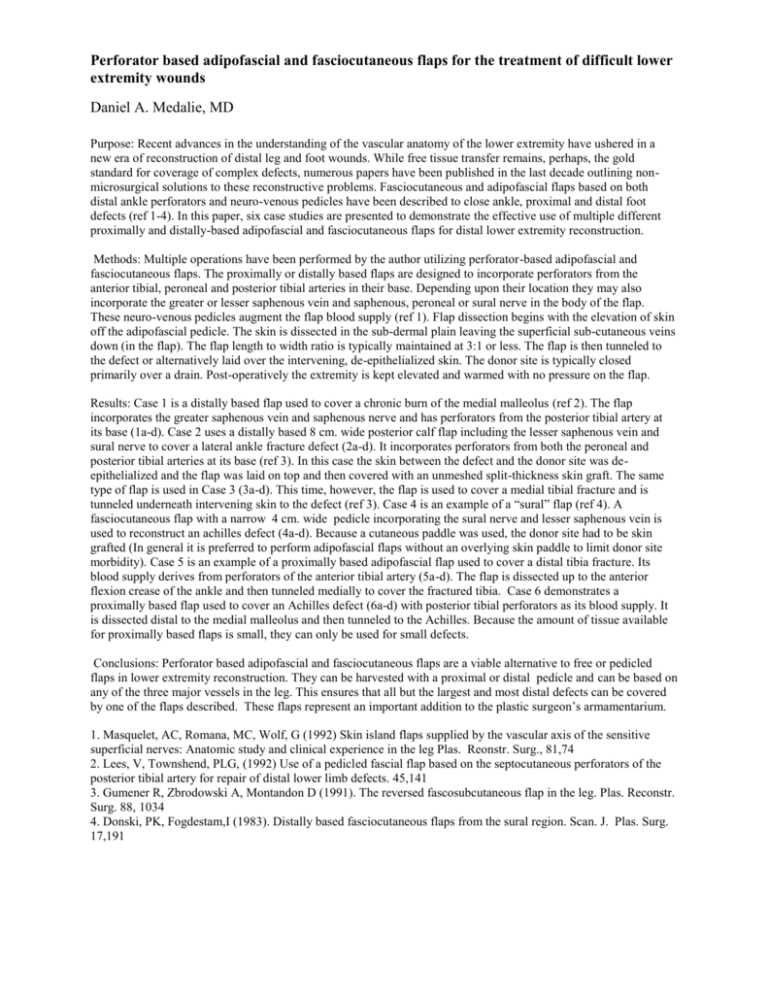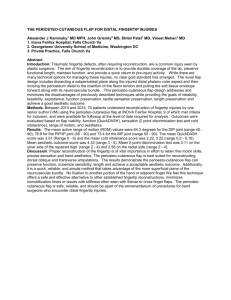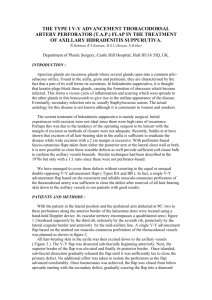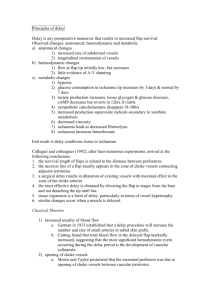Perforator based adipofascial and fasciocutaneous flaps for
advertisement

Perforator based adipofascial and fasciocutaneous flaps for the treatment of difficult lower extremity wounds Daniel A. Medalie, MD Purpose: Recent advances in the understanding of the vascular anatomy of the lower extremity have ushered in a new era of reconstruction of distal leg and foot wounds. While free tissue transfer remains, perhaps, the gold standard for coverage of complex defects, numerous papers have been published in the last decade outlining nonmicrosurgical solutions to these reconstructive problems. Fasciocutaneous and adipofascial flaps based on both distal ankle perforators and neuro-venous pedicles have been described to close ankle, proximal and distal foot defects (ref 1-4). In this paper, six case studies are presented to demonstrate the effective use of multiple different proximally and distally-based adipofascial and fasciocutaneous flaps for distal lower extremity reconstruction. Methods: Multiple operations have been performed by the author utilizing perforator-based adipofascial and fasciocutaneous flaps. The proximally or distally based flaps are designed to incorporate perforators from the anterior tibial, peroneal and posterior tibial arteries in their base. Depending upon their location they may also incorporate the greater or lesser saphenous vein and saphenous, peroneal or sural nerve in the body of the flap. These neuro-venous pedicles augment the flap blood supply (ref 1). Flap dissection begins with the elevation of skin off the adipofascial pedicle. The skin is dissected in the sub-dermal plain leaving the superficial sub-cutaneous veins down (in the flap). The flap length to width ratio is typically maintained at 3:1 or less. The flap is then tunneled to the defect or alternatively laid over the intervening, de-epithelialized skin. The donor site is typically closed primarily over a drain. Post-operatively the extremity is kept elevated and warmed with no pressure on the flap. Results: Case 1 is a distally based flap used to cover a chronic burn of the medial malleolus (ref 2). The flap incorporates the greater saphenous vein and saphenous nerve and has perforators from the posterior tibial artery at its base (1a-d). Case 2 uses a distally based 8 cm. wide posterior calf flap including the lesser saphenous vein and sural nerve to cover a lateral ankle fracture defect (2a-d). It incorporates perforators from both the peroneal and posterior tibial arteries at its base (ref 3). In this case the skin between the defect and the donor site was deepithelialized and the flap was laid on top and then covered with an unmeshed split-thickness skin graft. The same type of flap is used in Case 3 (3a-d). This time, however, the flap is used to cover a medial tibial fracture and is tunneled underneath intervening skin to the defect (ref 3). Case 4 is an example of a “sural” flap (ref 4). A fasciocutaneous flap with a narrow 4 cm. wide pedicle incorporating the sural nerve and lesser saphenous vein is used to reconstruct an achilles defect (4a-d). Because a cutaneous paddle was used, the donor site had to be skin grafted (In general it is preferred to perform adipofascial flaps without an overlying skin paddle to limit donor site morbidity). Case 5 is an example of a proximally based adipofascial flap used to cover a distal tibia fracture. Its blood supply derives from perforators of the anterior tibial artery (5a-d). The flap is dissected up to the anterior flexion crease of the ankle and then tunneled medially to cover the fractured tibia. Case 6 demonstrates a proximally based flap used to cover an Achilles defect (6a-d) with posterior tibial perforators as its blood supply. It is dissected distal to the medial malleolus and then tunneled to the Achilles. Because the amount of tissue available for proximally based flaps is small, they can only be used for small defects. Conclusions: Perforator based adipofascial and fasciocutaneous flaps are a viable alternative to free or pedicled flaps in lower extremity reconstruction. They can be harvested with a proximal or distal pedicle and can be based on any of the three major vessels in the leg. This ensures that all but the largest and most distal defects can be covered by one of the flaps described. These flaps represent an important addition to the plastic surgeon’s armamentarium. 1. Masquelet, AC, Romana, MC, Wolf, G (1992) Skin island flaps supplied by the vascular axis of the sensitive superficial nerves: Anatomic study and clinical experience in the leg Plas. Reonstr. Surg., 81,74 2. Lees, V, Townshend, PLG, (1992) Use of a pedicled fascial flap based on the septocutaneous perforators of the posterior tibial artery for repair of distal lower limb defects. 45,141 3. Gumener R, Zbrodowski A, Montandon D (1991). The reversed fascosubcutaneous flap in the leg. Plas. Reconstr. Surg. 88, 1034 4. Donski, PK, Fogdestam,I (1983). Distally based fasciocutaneous flaps from the sural region. Scan. J. Plas. Surg. 17,191 1b 1a 1d 1c 2a 2b 2a 2b 2c 2d 2c 3a 2d 3b 3a 3b 3c 4a 3 c 4c 4b 3d 4d 5a 5b 5c 5d 6a 6b











